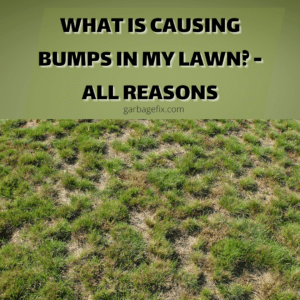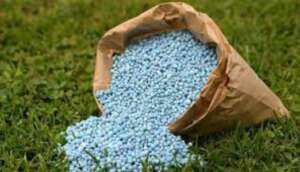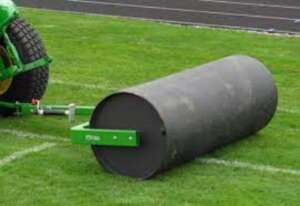Table of Contents

Sometimes, when you look at your lawn, wondering what is going on with it. You thought your lawn was well-kept and healthy, but there are bumps everywhere. The mystery of what is causing the bumps in the lawn only adds to our anxiety.
These bumps can create a bad visual appearance and make it hard for grass to grow on the affected areas of your lawn. But to determine if there is an easy fix or if you need to do some lawn repairs, you’ll first have to learn what is causing these bumps in your lawn!
In this article, I have listed some methods to get rid of those bumps from your lawn as they can be a major headache if not treated early.
Reasons for Bumpy Lawn
It’s annoying that your grass looks like a roller coaster! Any of the following could cause wavy grass:
Freezing and thawing
It can cause soil to lift and heave, making thin grass rough. This frequently happens in the high Valley area.
Bumpy lawns may result from earthworms and nightcrawlers, which leave behind little clods of soil on the soil’s surface. Castings are lumps that can cause unevenness in the grass.
Animals
One possible source of the bumps is animals rummaging around in your yard. Skunks make little holes when digging for insects to consume; when raccoons look for grubs and other bug larvae, they will roll up a lawn.
Improper Grading:
A poorly graded yard is a more severe cause than a bumpy yard and can lead to more difficulties if water runs toward your home rather than away from it.
Close roots of Trees
Trees in your yard should be aware that some may have unusually close roots. Your uneven grass may be the result of these roots.
Tools for Levelling Grass
A hand rake, landscape rake, plastic leaf rake, large push broom, shovel, edger, and wheelbarrow are the bare minimum tools required to achieve a flat lawn. In addition, you can use a levelling rake. This is the best instrument for spreading out levelling materials, and greenskeepers on golf courses use it regularly.
In addition to removing stones, it also disperses small clumps and leaves behind a perfectly even texture. Regarding final leveling, it outperforms a simple landscape rake or pushed broom.
Mechanism Disturbances
As the spring arrives and the soil is pliable, you can sometimes walk right over small bumps (less than an inch) to smooth them out. In addition, You can utilize a roller filled with water. You can water the lawn by filling the roller approximately a third of the way with water and then rolling it back and forth across the grass. Apply more water and try again if the surface is still uneven. Please don’t overdo it; too much rolling might compact the soil and lead to additional issues.
Topdressing
Topdressing with excellent topsoil or compost may be your best bet for mild issues. Before applying topsoil, You should severely mow down the grass or affected area. It may level the topsoil, and the site can be seen more clearly.

Please don’t put down more than half an inch at a time, and spread it out evenly without burying the grass. The topsoil won’t stop the grass from expanding. Add more topsoil, half an inch at a time, for several months, if necessary, to bring the area to a uniform level.
You may fill a deeper but small hole with soil, and grass can be allowed to grow back in if a healthy lawn surrounds it. It will be necessary to seed or sod across more prominent regions.
Patching up Minor Flaws
To fix minor animal holes, it may be sufficient to replace the disturbed dirt and add a layer of topsoil. When they’re small enough, the surrounding vegetation can cover them up. Topsoil should be used to fill in somewhat larger holes once they have been compacted and leveled.
Replace the grass on your lawn with more of the same kind. The seed must be carefully nourished and watered. See my discussion of overseeding in this article. I suggest applying a spray like this on ant hills. After several failed attempts, I finally employed a spray that killed the ants without harming the grass.
Fertilizer
If you have laid sod, you should roll the grass thoroughly to stabilize it and lessen the footprints people leave in the coming weeks. If you want your grass to grow again, you need to water it regularly. To promote root development, you should apply fertilizer. When a new lawn is sodded or seeded, it’s best to keep people and animals off it for a few weeks. Create a barrier to save people and animals from the sod or seed.

Rolling Your Lawn
The use of a lawn roller to achieve a uniform grass height is suggested in the following article: • Rolling Your Lawn •. My recommendation is this: DON’T DO IT! This is the very worst thing you could do. It makes sense. However, the soil is too compacted after being leveled with a roller to support grass growth.

Safety Precautions
After you’ve finished leveling your lawn, it’s essential to take precautions to ensure that no additional bumps or depressions appear. Some of the precautionary measures are:
- Switch up your mowing pattern between passes to prevent ruts from being carved into the grass by the lawnmower’s wheels.
- Also, avoid walking on the grass when it’s wet.
- Maintaining a thick and healthy lawn is the best defense against lumps and bumps.
- Regular aeration helps soil retain moisture and delivers oxygen and nutrients to plant roots.
- To achieve thicker grass, overseeding is necessary.
- To maintain your grass healthily and green, treat it periodically with a nitrogen-rich fertilizer like Milorganite.
Conclusion
This article presented the reasons for a Bumpy lawn, a complete guide on the removal of bumps, and precautionary measures to avoid rollercoasters on your lawn. If you’ve gone through the article, hopefully, you’ve gained some insight on removing lawn bumps. Maintaining a level lawn may seem daunting, but it’s pretty simple, and the results will speak for themselves.
